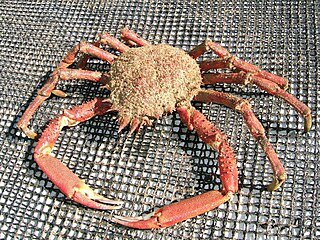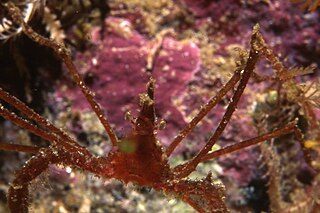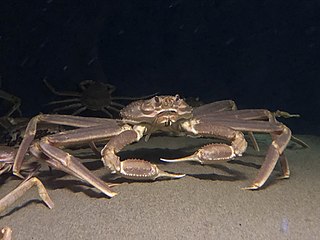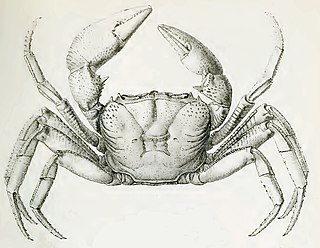
Huntsman spiders, members of the family Sparassidae, are known by this name because of their speed and mode of hunting. They are also called giant crab spiders because of their size and appearance. Larger species sometimes are referred to as wood spiders, because of their preference for woody places. In southern Africa the genus Palystes are known as rain spiders or lizard-eating spiders. Commonly, they are confused with baboon spiders from the Mygalomorphae infraorder, which are not closely related.

The red knot or just knot is a medium-sized shorebird which breeds in tundra and the Arctic Cordillera in the far north of Canada, Europe, and Russia. It is a large member of the Calidris sandpipers, second only to the great knot. Six subspecies are recognised.

Libinia emarginata, the portly spider crab, common spider crab or nine-spined spider crab, is a species of stenohaline crab that lives on the Atlantic coast of North America.

The Japanese spider crab is a species of marine crab that lives in the waters around Japan. It has the largest known leg-span of any arthropod.The Japanese name for this species is taka-ashi-gani,, literally translating to “tall legs crab”. It goes through three main larval stages along with a prezoeal stage to grow to its great size.

Carcinus maenas is a common littoral crab. It is known by different names around the world. In the British Isles, it is generally referred to as the shore crab, or green shore crab. In North America and South Africa, it bears the name European green crab.

Maja squinado is a species of migratory crab found in the north-east Atlantic and the Mediterranean Sea. The appearance of the European spider crab is similar to the much larger Japanese spider crab.
Helcogramma obtusirostris, the hotlips triplefin or shortsnout triplefin, is a triplefin blenny of the family Tripterygiidae, found from the Red Sea south to South Africa and east to the western Pacific, and the southeast Atlantic, around Ascension Island and St. Helena. It reaches a maximum length of 3.8 cm according to FishBase, but only 4 cm according to "Two Oceans".

The coconut crab is a species of very large terrestrial hermit crab, and is also known as the robber crab or palm thief. It is the largest terrestrial arthropod known, with a weight of up to 4.1 kg (9 lb). The distance from the tip of one leg to the tip of another can be as wide as 1 m. It is found on islands across the Indian and Pacific Oceans, as far east as the Gambier Islands, Pitcairn Islands and Caroline Island and as far south as Zanzibar. While its range broadly shadows the distribution of the coconut palm, the coconut crab has been extirpated from most areas with a significant human population such as mainland Australia and Madagascar.
Hexapodidae is a family of crabs, the only family in the superfamily Hexapodoidea. It has traditionally been treated as a subfamily of the family Goneplacidae, and was originally described as a subfamily of Pinnotheridae. Its members can be distinguished from all other true crabs by the reduction of the thorax, such that only seven sternites are exposed, and only four pairs of pereiopods are present. Not counting the enlarged pair of claws, this leaves only six walking legs, from which the type genus Hexapus, and therefore the whole family, takes its name. Some anomuran "crabs", such as porcelain crabs and king crabs also have only four visible pairs of legs. With the exception of Stevea williamsi, from Mexico, all the extant members are found either in the Indo-Pacific oceans, or around the coast of Africa.

Ranina ranina, also known as the Huỳnh Đế crab, (red) frog crab or spanner crab, is a species of crab found throughout tropical and subtropical habitats. It is often fished for its meat, and is the only known species in its genus.

Maguimithrax spinosissimus, also known as the West Indian spider crab, channel clinging crab, reef or spiny spider crab, and coral crab, is a species of spider crab that occurs throughout South Florida and across the Caribbean Islands.

Gecarcinus ruricola is a species of terrestrial crab. It is the most terrestrial of the Caribbean land crabs, and is found from western Cuba across the Antilles as far east as Barbados. Common names for G. ruricola include the purple land crab, black land crab, red land crab, and zombie crab.

Macropodia falcifera, the Cape long-legged spider crab, is a species of marine crab found around the South African coast. It is a member of the family Inachidae.

Acanthonyx dentatus, the toothed decorator crab, is a species of crab in the family Inachidae.
Maja capensis, the Agulhas spider crab, is a species of crab in the family Majidae.

Chionoecetes opilio, a species of snow crab, also known as opilio crab or opies, is a predominantly epifaunal crustacean native to shelf depths in the northwest Atlantic Ocean and north Pacific Ocean. It is a well-known commercial species of Chionoecetes, often caught with traps or by trawling. Seven species are in the genus Chionoecetes, all of which bear the name "snow crab". C. opilio is related to C. bairdi, commonly known as the tanner crab, and other crab species found in the cold, northern oceans.

Seychellum alluaudi is a species of freshwater crab endemic to the Seychelles, and the only true freshwater crab in that country. It lives in rainforest streams on the archipelago's granitic high islands. Although it may be abundant, little is known about its biology. If its habitat were to decline in quality, S. alluaudi might become endangered, but it is currently listed as Vulnerable on the IUCN Red List.

Libinia dubia, the longnose spider crab, is a species of crab in the family Epialtidae. It is found in shallow waters on the eastern coast of North America.
Libinia ferreirae is a species of tropical spider crab in the family Epialtidae. It is found on the seabed in shallow waters off the Atlantic coast of South America.

Paraleptuca chlorophthalmus, is a common fiddler crab found in the mangroves of East Africa, from Somalia to South Africa, as well as Madagascar and Mauritius. Marsh fiddlers dig burrows in the muddy or sandy banks of salt marshes, which they use to protect themselves from predators, high tide and extreme temperatures. They feed by filtering detritus out of mud, and defend their burrows against other fiddler crabs. Paraleptuca chlorophthalmus is characterised by its red pereiopods and blue and black markings on its carapace.

















